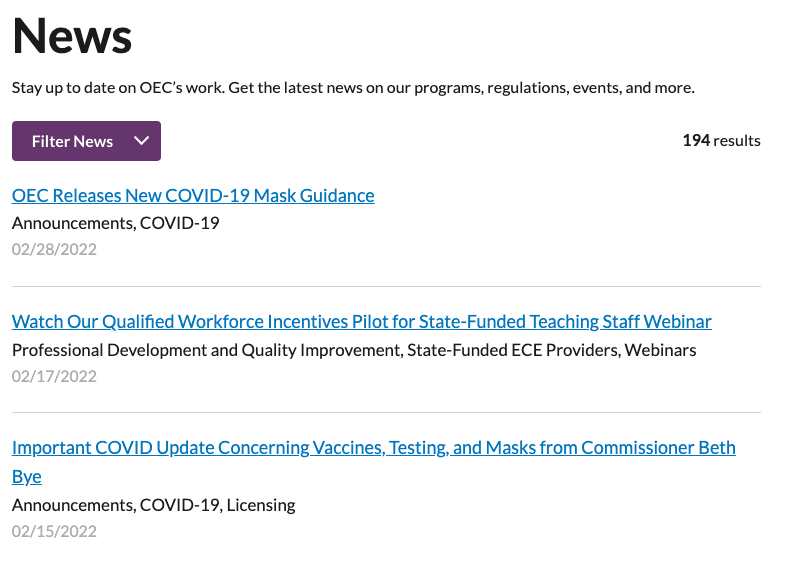Do you have a new OEC initiative, policy, or campaign you want to announce? Want to share important information with families or early child care professionals? It’s important to choose the right format for your audience.
Below you’ll find a rundown of the pros and cons for different formats — you’ll likely use a combination for your project.
Web content
The website is our primary way of communicating with our audiences — so no matter what you’re working on, the website needs to be part of your strategy from the start.
Remember that one of the first steps in our editorial process is to check in with the Website Advisory Team to talk about your goals. Email Maggie Adair to get on the agenda of our next weekly meeting.
OEC has traditionally used email and our listserv to communicate with providers, and it’s still an important form of communication — especially for more formal announcements and policies. Check with X if you’re interested in sharing information through the listserv.
Instead of attaching a PDF to your email, consider adding a link to a news post instead. That way, if you need to make changes, you can quickly update the news post instead of sending out a second email with an updated PDF.
News posts on the website

News posts are perfect for announcements of new policies, programs, or webinars. You can tag your news post with a specific topic — such as “Licensing” or “Webinars,” so it’s easy for people to find.
News posts also appear on multiple pages: the home page (in the news box), the news page, and any relevant topic-related news pages (for example, here’s the news page with all posts tagged “Licensing”).
However, news posts are not the right choice for information that you want people to refer back to. Users may not trust news posts as a reference once they’re a few months old. Learn more about creating news posts.
PDFs and other print materials
PDFs — whether they’re simple Word docs converted to a PDF or fully-designed with images — are ideal for certain types of content, such as:
- Anything that’s supposed to be printed (like a handout or poster)
- Long reference documents (like guides with pagination)
However, web is a better choice than PDF for most other types of content. Here’s why:
- PDFs are harder to keep up to date. Web updates take a few minutes. But updating a designed PDF takes time — it has to be taken down, edited (which OEC can’t do in-house), and then uploaded to the website. If you have information that’s likely to need a lot of updates, don’t use a PDF.
- PDFs pose accessibility problems. Users need plugins or software on their computer or phone to open PDFs. Screen readers for people with visual impairments may not recognize text in PDF format.
- PDFs are not good for mobile. PDFs are designed to be read on an 8.5 x 11 inch piece of paper, not a 5 inch mobile screen. Almost 50% of OEC web traffic is mobile.
- PDFs create version-control problems. Every PDF file needs to be updated separately. Plus, OEC has no control over out-of-date versions that users downloaded previously.
Social media
OEC has a an active social media presence on:
It’s a great way to catch the eye of both families and professionals. Keep in mind that you’ll want any social media posts to link back to the website to drive traffic.
OEC used to have a number of separate websites with their own addresses outside of the main site — like safesleep and Hello Kindergarten!
However, we’ve generally stopped using this approach for a few reasons.
–We want the OEC website to be our main resource. If we have valuable information to share, we want it integrated into our own website.
–Our current website is much easier for staff to use. Microsites were a more reasonable option with our old website, which was hard to update.
–OEC staff doesn’t have direct control over microsites. Instead, we’re reliant on contractors who created the site to update it. Making updates is more expensive and takes longer.
–Microsites tend to get neglected. Microsites are harder to maintain in the long run — especially when staff leave or funding ends. As a result, the sites can linger on with out of date content. They can dilute or confuse OEC’s current messaging and online presence.
